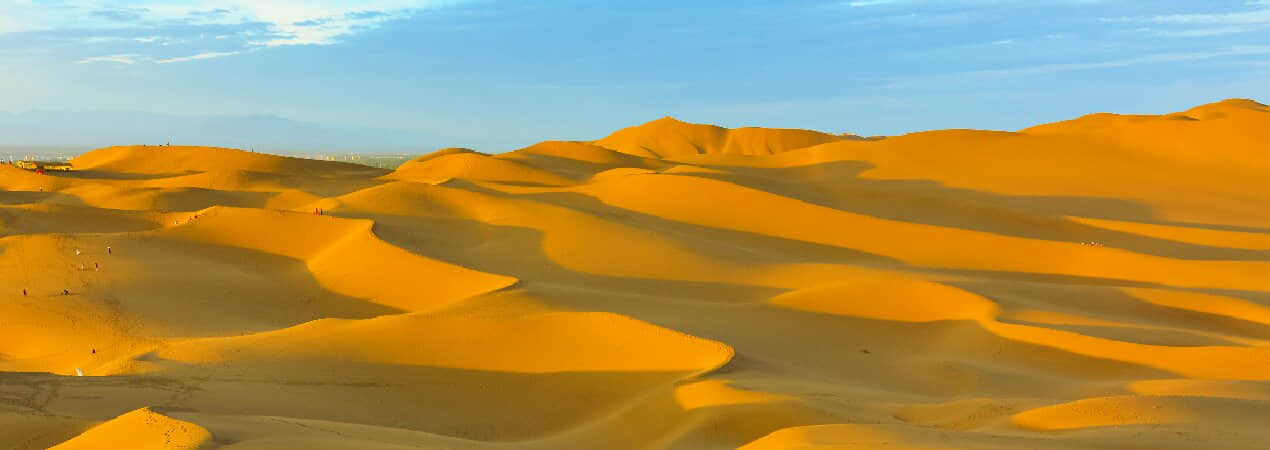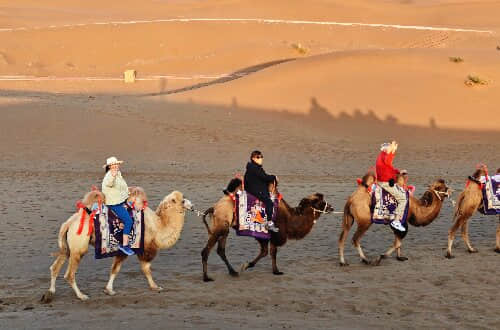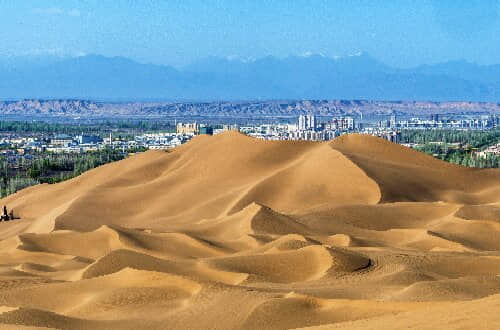Kumtag Desert

The Kumtag Desert Scenic Area has a total area of about 1,880 square kilometers and is part of the Kumuluk Desert, one of the eight major deserts in China. The desert is an extremely dry area with various unique gravel desert landscapes. Due to long-term wind erosion, the ground is uneven, forming a series of parallel hill ridges, crests, trenches, etc. with extremely steep slopes. The Kumtag Desert is famous for its unique aeolian landforms with complete types, clear sand dune contours and distinct layers. It is not only a good place for scientific research, exploration and adventure, but also an ideal place for sand sports, sand therapy and desert sightseeing.
- Chinese name: 库木塔格沙漠 Kù mù tǎ gé Shā mò
- Suggested time: 3 - 4 hours
- Ticket: The ticket price is 30 yuan per person. But it's advisable to check for any possible price adjustments on the official website or at the ticket office.
- Open hours: Winter: May - October: 09:30 - 20:00, November - April of the following year: 09:30 - 19:30
- The best time to visit: Spring (March - May) and autumn (September - November)
- Address: No. 999, Gongyuan Road, Shanshan County, Turpan, Xinjiang
- How to get there: Navigate to the Kumu Tag Desert Scenic Area in Shanshan County. There are parking lots available at the scenic area for self-driving tourists. The roads are in good condition, but pay attention to traffic signs, especially when approaching the desert area.
- Surroundings: Flaming Mountains
Highlights of Kumtag Desert
Happy Sand Valley
 Camel Riding
Camel RidingThe sand in Happy Sand Valley is fine and clean. Here, you can take off your shoes and socks to experience the fun of climbing sand dunes. In addition, many entertainment projects are set up in Happy Sand Valley, including crazy desert surf cars, thrilling yet safe sand motorcycles, exciting sand sliding, and leisurely camel riding. These will allow you to feel the passion and romance of the desert.
Tips: The desert is hot, so it is recommended to wear breathable and light clothing, and bring sunscreen, sunglasses and a sun hat. There is no water source in the desert, so you need to bring plenty of drinking water when you visit. The desert has complex terrain, so it is recommended to choose an experienced guide to avoid getting lost.
Thousand-Spring Sand Lake
The "Thousand-Spring Sand Lake" is a lake formed by thousands of springs. The water is rich in potassium salt, natural soda, natural alkali, iron oxide, and other trace elements, featuring clear quality and abundant water storage. Corridors and blue water reflect each other, forming a beautiful picture scroll. The beautiful scenery here can maximally inspire artistic creation inspiration—many ancient Chinese poets composed numerous praiseful poems for this charming landscape.
Sand Sculpture Area
The Kumtag Desert is dry and rainless year-round. Sand sculpture artists leverage the properties of sand to create works that blend historical culture and modern civilization. Using sand as the main material, they adopt deck solidification and carve from top to bottom. While ordinary sand sculptures typically only last a few months, those here can be preserved for nearly five years, earning them the reputation of a miracle in sand sculpture art. In addition to admiring the sand sculptures, visitors can enjoy the large-scale live-action stage play “Night of Loulan” at night, along with cockfight dances and torch dances, fully experiencing the local ethnic enthusiasm and adding fun to their journey.
Health-preserving Sand Therapy Area
Sand therapy is a major feature of this desert. As an important part of Uyghur medicine with a long history, it benefits from gravel rich in rare metal elements such as iron, boron, magnetic minerals, and manganese. These elements have miraculous curative effects on treating various rheumatic diseases, lumbar and back pain, arthritis, joint pain, etc. Every summer, tourists from home and abroad flock here for sand therapy.
Educational Value
 Kumtag Desert
Kumtag DesertThe Kumtag Desert is formed primarily by the southwest wind from the Qijiaojing wind outlet of the Tianshan Mountains and the southeast wind from the Dabancheng wind outlet. These two winds, carrying massive sand particles over long distances, eventually converge and deposit in the Kumtag area. The southern Kuruktag Mountain also contributes to wind weakening in both directions and aeolian deposition, forming a unique landscape of sand dunes. Visitors can observe typical landforms like crescent-shaped and honeycomb-shaped dunes, and understand the interactive relationship between wind action and the geographical environment.
Activities to do at Kumtag Desert
Planting desert vegetation: Adopt drought-resistant seedlings such as saxaul trees and tamarisks, learn drip irrigation techniques, and regularly check the growth status of plants through online platforms.
Desert art creation: Organize desert poetry gatherings and sketching activities, using sand dunes, camel caravans, and starry skies as creative materials for literary and artistic works.
Drop us a line and we'll connect you with the top China expert in no time!